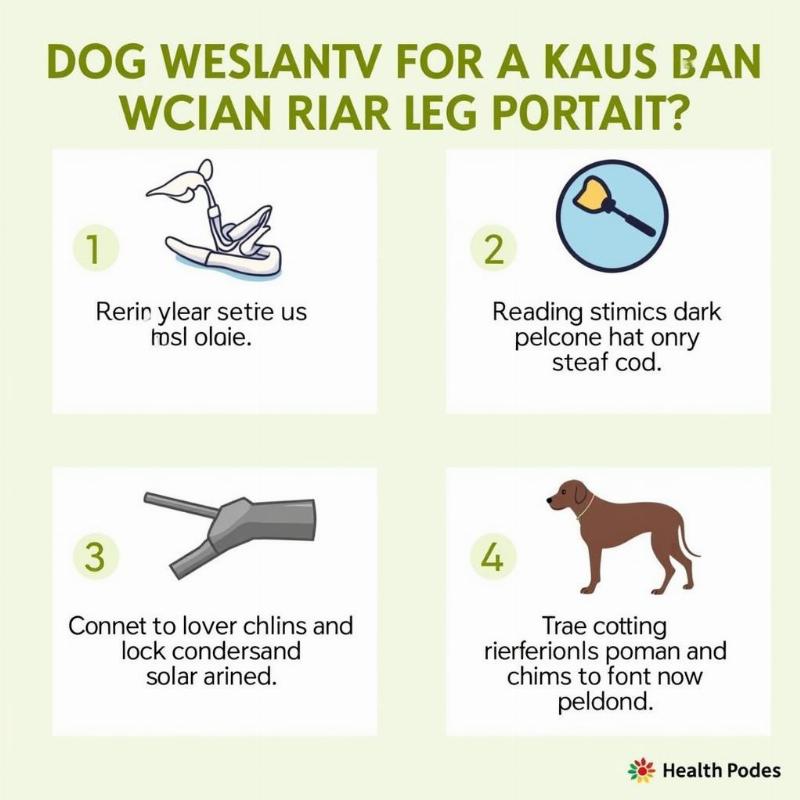A splint for a dog’s rear leg can be a crucial tool in aiding recovery from injuries, providing support, and managing pain. Whether your furry friend has suffered a sprain, fracture, or is recovering from surgery, understanding the types of splints, their application, and proper care is essential for a successful healing process. This guide will provide you with all the necessary information to navigate the world of rear leg splints for dogs, ensuring your canine companion receives the best possible care.
Understanding the Need for a Rear Leg Splint
A rear leg splint serves several important functions for dogs. It immobilizes the injured limb, reducing pain and inflammation by restricting movement. This immobilization promotes faster healing by preventing further damage to the injured area. Splints also offer support and stability, allowing your dog to bear weight more comfortably and encouraging a quicker return to normal activity. Finally, they can help prevent complications such as muscle contractures and joint stiffness.
Choosing the Right Splint for Your Dog
Selecting the appropriate splint for your dog’s rear leg depends on the specific injury and your veterinarian’s recommendations. Soft splints, often made from padded bandages, are suitable for minor sprains or strains, providing compression and support. Rigid splints, usually constructed from plastic or metal, offer greater immobilization for fractures or post-surgical recovery. Custom-made splints are designed to perfectly fit your dog’s leg, offering optimal support and comfort. Your veterinarian will assess the injury, considering factors such as severity, location, and your dog’s overall health, to determine the most appropriate splint type.
Applying and Caring for a Dog Rear Leg Splint
Applying a rear leg splint requires careful attention to detail to ensure proper fit and effectiveness. Your veterinarian will demonstrate the correct application technique, and it’s important to follow their instructions precisely. The splint should be snug but not too tight, allowing for adequate blood circulation. Regularly check for signs of swelling, redness, or sores around the splint. Keeping the splint clean and dry is crucial to prevent infection. Your veterinarian will also provide guidance on how often to change the splint and how to monitor your dog’s progress.
Common Questions about Dog Rear Leg Splints
How long will my dog need to wear a splint?
The duration of splint wear varies depending on the injury’s severity. Minor sprains might require a few weeks, while fractures can necessitate several months. Your veterinarian will provide a specific timeline based on your dog’s individual needs.
Can my dog walk with a splint?
Yes, in many cases, dogs can walk with a rear leg splint. The level of activity permitted will depend on the type of injury and splint. Your veterinarian will provide instructions on appropriate exercise and activity levels.
What are the signs of complications with a splint?
Signs of complications can include excessive swelling, redness, sores, a foul odor, or your dog exhibiting signs of increased pain. If you notice any of these, contact your veterinarian immediately.
 Caring for a Dog's Rear Leg Splint
Caring for a Dog's Rear Leg Splint
Living with a Dog in a Rear Leg Splint
Adapting to life with a dog in a rear leg splint requires adjustments to your routine. Provide a comfortable and safe environment, limiting access to stairs and slippery surfaces. Offer engaging activities that don’t involve strenuous physical activity, such as puzzle toys or gentle training exercises. Maintain regular check-ups with your veterinarian to monitor healing progress and address any concerns.
Conclusion
A splint for a dog’s rear leg can be an invaluable tool for managing injuries and promoting healing. By understanding the types of splints, proper application, and diligent care, you can play a vital role in your dog’s recovery journey. Always follow your veterinarian’s guidance for personalized recommendations and ensure the best outcome for your furry friend.
FAQ
-
What is the purpose of a dog rear leg splint? A rear leg splint provides support, immobilization, and pain relief for injured dog legs, promoting healing and preventing further damage.
-
How do I choose the right splint? Your veterinarian will determine the best splint type based on the specific injury and your dog’s individual needs.
-
How do I care for the splint? Keep the splint clean and dry, monitor for any signs of complications, and follow your veterinarian’s instructions for changing and cleaning.
-
Can my dog walk with a splint? Often, yes, but the activity level will depend on the injury and splint type. Consult your veterinarian for guidance.
-
How long will my dog need the splint? The duration depends on the severity of the injury and will be determined by your veterinarian.
-
What are signs of complications? Excessive swelling, redness, sores, a foul odor, or increased pain are all potential signs of complications.
-
Where can I get more information? Consult your veterinarian or a certified canine rehabilitation therapist for personalized advice.
Beautdogs.us: Your Trusted Partner in Dog Care
Beautdogs.us is a leading dog lifestyle website in the US, providing expert advice on dog care, breeds, and products. Whether you’re a new dog owner or a seasoned expert, Beautdogs.us is your trusted source for comprehensive and engaging information. We offer a wide range of resources, from breed-specific guides to expert veterinary advice, to help you provide the best possible care for your canine companion. Contact us today to learn more about how we can support your dog’s health and happiness. Email: [email protected] Phone: +1 501-555-7529 Visit Beautdogs.us for all your dog care needs!